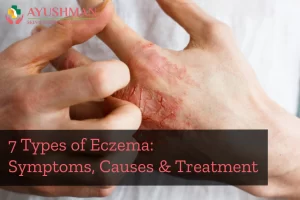Table of Contents
ToggleWhat is Alopecia Areata Treatment?
Alopecia is a condition where your hair falls out in patches. It’s more noticeable when these patches connect over time. This happens because your immune system mistakenly attacks your hair follicles. It’s a common disorder that can affect anyone, regardless of age.
Alopecia can occur on various body parts, such as the scalp, eyelashes, eyebrows, face, and legs. Some experts think men might be more susceptible to alopecia than women, but it can affect both genders significantly. Typically, alopecia starts between the ages of 25 and 36.
There are different types of alopecia:
- Alopecia Areata: This is the most common form, causing hair loss in patches.
- Alopecia Areata Totalis: In this type, you lose all the hair on your head.
- Alopecia Areata Universalis: This involves losing hair all over your body.
- Diffuse Alopecia Areata: Instead of patches, you experience sudden thinning of your hair.
- Ophiasis Alopecia Areata: This type causes hair loss in a band shape around the sides and back of your head.
Hair may grow back and fall out again, or it may grow back permanently. The severity of hair loss differs from individual to individual.
Want to treat your alopecia areata? Contact us today! We provide the best Alopecia Areata Treatment in Dwarka. Call us at +91-9599816604 or +91-9599816603.
Symptoms of Alopecia
The main symptom of alopecia is hair loss, and here’s what you might notice:
- Small bald patches on your scalp or other body parts.
- These patches might get larger and merge into a bigger bald spot.
- Hair can grow back in one spot and fall out in another.
- More hair loss during cold weather.
- Your fingernails and toenails may turn red, become brittle, and have pits.
The skin in the bald patches is smooth, without any rash or redness. However, you might feel a tingling, itching, or burning sensation on your skin just before the hair falls out.
Causes and Risk Factors of Alopecia
in alopecia areata, an autoimmune disease, your immune system mistakenly attacks your hair follicles. The exact reason why this happens is not clear to doctors, but they believe it might be linked to certain genetic factors. Something in your genes may make you more prone to it, and then some trigger causes the hair loss.
You are more likely to get alopecia areata disorder if you have:
- A family member with the condition.
- Asthma.
- Down syndrome.
- Pernicious anemia.
- Seasonal allergies.
- Thyroid disease.
- Vitiligo.
Alopecia Diagnosis
If you suspect you have alopecia areata, it’s a good idea to visit a skin specialist known as a dermatologist. During the visit, they will:
- Discuss your symptoms with you.
- Examine the areas where you are experiencing hair loss.
- Gently pull on the hairs at the edges of the bald patch to check for easy hair loss.
- Inspect individual hairs and follicles to see if they have any abnormal shapes.
- Evaluate the condition of your nails.
In some cases, a biopsy may be performed, involving the removal of a small piece of skin from your scalp for microscopic examination.
Since various conditions can lead to hair loss, your doctor might also conduct tests to rule out other possibilities. These tests may include checking for fungal infections on your skin or conducting blood tests to assess thyroid function, hormone levels, or immune system issues.
Treatment Options for Different Types of Alopecia Areata
Although there is no cure for alopecia, various treatments can help regrow hair or slow down further hair loss. Here are some commonly used treatments for different types of alopecia:
Microneedling:
A newer treatment that stimulates new hair growth by puncturing the scalp with tiny needles. Promotes collagen production, aiding in hair restoration. Beneficial for alopecia areata, androgenic alopecia, and ophiasis alopecia.
Minoxidil (Rogaine):
Over-the-counter medication is applied topically to areas experiencing hair loss. Effective for alopecia areata, CCCA, diffuse alopecia areata, ophiasis alopecia, and persistent patchy alopecia areata.
Stress Reduction:
Managing stress with challenging life events can sometimes prevent hair loss triggered by severe stressors. Particularly helpful for diffuse alopecia areata.
Immunotherapy:
Medications like tofacitinib and cyclosporine can suppress the body’s immune response. Topical immunotherapy is considered a safe and effective long-term treatment for alopecia areata, and immunotherapy may be recommended for lichen planopilaris.
Platelet-Rich Plasma (PRP) Injections:
PRP involves isolating and concentrating plasma from your blood. Injecting PRP into damaged tissues may stimulate the growth of new, healthy cells and promote healing. Shown to decrease hair loss and increase hair growth in studies, making the scalp a healthier environment for hair growth.
Other Causes of Hair Loss
Alopecia is just one of several reasons why people may experience hair loss. There are other types of hair loss, some of which are treatable with medications or hair restoration procedures. Here are different causes:
- Age-related: Many hair follicles naturally stop producing hair as we age.
- Cancer Treatment: Both radiation and chemotherapy can lead to hair loss, usually temporary.
- Hair Care Products: Certain products and hairstyles may damage hair follicles.
- Hormonal Imbalance: More common in women, especially those with polycystic ovary syndrome.
- Scalp Infection: Inflammation of the scalp can result in temporary hair loss and red, scaly skin patches.
- Stress: Physical and emotional stress can be a factor in hair loss, but once the stress is relieved, hair loss often stops.
- Thyroid Disease: Thinning hair and hair loss are common symptoms, but effective thyroid treatment can reverse these effects.
Conclusion
Alopecia can appear suddenly and follow an unpredictable course. While hair might grow back naturally in some cases, seeking treatment is often necessary to promote healthy hair regrowth. If you observe any hair loss on your body, it’s essential to visit a dermatologist promptly to explore your options.
Effective treatment may involve a mix of medications and procedures. With patience, you may be able to prevent more hair loss and even recover some of the lost hair. If restoring natural growth isn’t feasible, a dermatologist can suggest alternatives such as hair restoration procedures, wigs, or other options.
FAQs (Alopecia Areata Treatment in Dwarka)
Q: Is there a cure for alopecia?
A: Currently, there is no cure for alopecia, but various treatments, including medications, microneedling, and corticosteroids, may help promote hair regrowth and slow down further hair loss.
Q: What are the causes and risk factors for alopecia?
A:The exact cause is unknown, but genetic factors may play a role. Risk factors include a family history of alopecia, certain medical conditions like asthma or thyroid disease, and hormonal imbalances.
Q: How is alopecia diagnosed?
A:Dermatologists typically diagnose alopecia by discussing symptoms, examining areas of hair loss, and sometimes performing a biopsy or other tests to rule out other conditions.
Q: Can stress cause alopecia?
A:Stress can contribute to hair loss, especially in cases of diffuse alopecia areata. Managing stress may help prevent or reduce hair loss triggered by stressors.
Q: Is hair loss due to alopecia permanent?
A:Hair loss patterns can vary, and while some people experience regrowth, others may have permanent hair loss. Treatment can influence outcomes.






